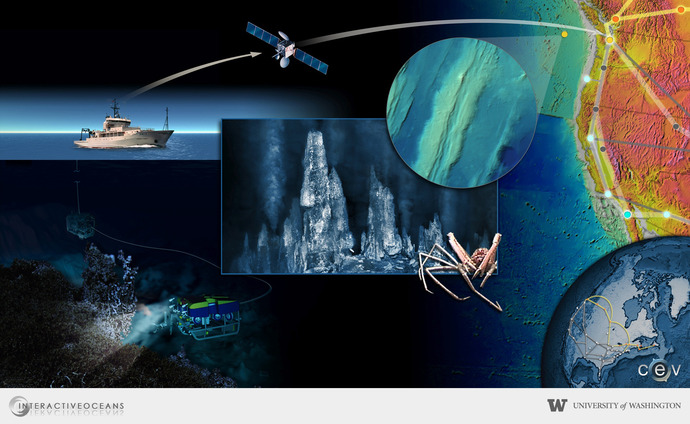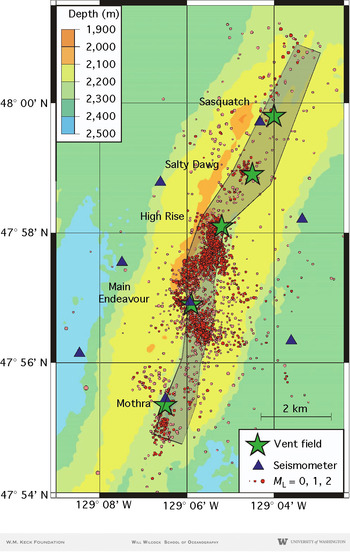In 2001, the W.M. Keck Foundation provided a $5 million gift to the University of Washington for a project that focused on two basic elements:
1) Begin implementation of the Northeast Pacific Time-Integrated Undersea Networked Experiments (NEPTUNE) concept. The novel submarine technology of NEPTUNE is designed to bring high power and high bandwidth to the ocean basins in order to empower real-time, interactive research for decades.
2) The Five-Year Proto-NEPTUNE Experiment. Through development of novel seafloor sensors, this experiment was designed to explore the plate-tectonic triggering mechanisms responsible for thermal, chemical, and biological fluxes into the overlying ocean from below the seafloor. A Keck-funded set of prototype observatories located at three major tectonic plate boundaries was the first step toward cabling the Juan de Fuca Plate and its overlying ocean. By 2006 a total of 40 new instruments had been developed and deployed at the undersea observatories.
Discoveries and technological advances made during this program include the following:
- Submarine Earthquakes: Seismic activity is the major expression of either mechanical deformation or volcanic activity. Newly developed deployment approaches were utilized during the Keck-NEPTUNE program to enhance the coupling between seismometers and the seafloor. Local seismic networks were operated for periods of one to three years in locations that included the actively spreading Endeavour ridge and hydrothermal setting, the Nootka Transform Fault, and a convergent plate setting. Evidence from the Endeavour experiment led to the new conclusion that earthquake activity is directly proportional to the level of heat flux from specific vent fields.
- Seismicity, fluid flow, and life: Coupled in situ fluid and microbial DNA samplers were developed for year-long deployments at vent sites. Fluid chemistry and microbial populations indicate identifiable "fingerprints" for specific locations on the seafloor despite earthquake disturbances. Vents maintain unique microbial communities over time.
- Boiling on the seafloor: A unique sensor was developed to make reliable in situ chloride measurements as a means of studying the linkages among seismic activity, boiling, and the hydrothermal fluid chemistry in active submarine hydrothermal systems. At the Endeavour vents, boiling occurs 2000 m (7000 feet) beneath the ocean's surface. The in situ instruments provided first-time documentation for the direct, real-time connection between measured seismic activity and the induced chemical changes in output fluids from nearby vents. There are intriguing high-salinity bursts from hydrothermal systems that seem unrelated to seismic activity.
- Life in the Extreme: Keck and the National Science Foundation funded the development and installation of a novel incubator system that allows in situ exploration of the upper-temperature conditions under which life can exist. Results from year-long deployments of the incubators inside the walls of an actively venting black smoker chimney hint that life may exist at temperatures in excess of 150°C. Inside porous chimney walls, rich and diverse microbial communities are supported by fluids formed when tidal pumping mixes cool, oxygen-rich seawater with high-temperature anoxic hydrothermal fluids.
- Booming Black Smokers: Few flow measurements exist of fluids exiting black smoker chimneys because placing physical sensors in the flow perturbs the flow regime. Yet such measurements are critical to the calculation of chemical and heat fluxes in these environments. To tackle this problem, a noninvasive stand-alone deep-sea digital acoustic recording system was developed and deployed at black smokers using hydrophones sampling the sound at 1000 Hz and 1920 Hz. The results of this preliminary study were very exciting and showed that there is significant sound produced by black smokers, sound that is within the audible range of humans as well as marine organisms.
- Watching Rocks Grow: During the five-year Keck-NEPTUNE study significant progress was made in our understanding of the geological and hydrothermal evolution of the Endeavour Observatory. The bathymetry of a significant portion of the axial valley and flanks was mapped at very high resolution by the autonomous vehicle ABE. These maps allowed us to see new features (faults, fissures, individual chimneys) critical to interpretation of the evolution of this dynamic system. One of the most dramatic changes has been the increased rate of chimney growth in two of the hydrothermal fields where new chimneys have grown 10 m (~30 feet) in 1 to 2 years.
- First Streaming of High-Definition Video From Sea: The first real-time broadcast of high-definition video from the seafloor occurred during the University of Washington VISIONS’05 Expedition. High-definition video is the most capable imaging medium for viewing and sharing the unparalleled deep seascapes festooned with exotic life forms that thrive on volcanic activity while living only centimeters away from 350°C (700°F) vent fluids billowing out of the seafloor. For this mission, HD video was transmitted to the Galaxy 10R communications satellite orbiting ~22,000 miles above the equator. The satellite transmission was received back at the University of Washington, where connections were made to stream the video in real-time over the Internet nationally and internationally, allowing scientists, educators, and the public to watch live exploration of vents.







